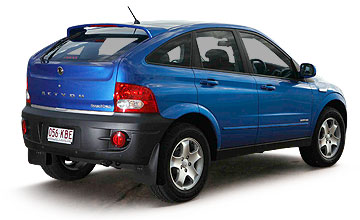BY JAMES STANFORD | 23rd Apr 2007

These refined wagons can’t go very far off-road, but deliver exactly what their customers want: A reasonably practical vehicle that drives much like a car, has an all-wheel-drive system that makes them feel safer in everyday conditions, and can master a gravel track once in a blue moon.
The Actyon is a similar price, but is completely different.
It has all the ingredients of a competent off-roader, but falls well short in other areas that mean so much to most compact SUV customers.
The Actyon is rear-wheel drive in most conditions, unlike its rivals that either run a constant all-wheel-drive or an on-demand AWD system.
The SsangYong centre locking differential 4WD system is great for serious off-road work with low-range and a limited-slip rear differential that works well on tricky dirt tracks.
That’s great if you head off into the bush looking for serious adventure, but is irrelevant to most compact SUV customers who are likely to prefer the additional safety net of AWD on tarmac for when it gets wet or greasy.
The SsangYong suffers from using a ladder frame chassis, rather than the moncoque (or one-piece) body used by cars and its compact SUV rivals.
Having a ladder frame may well help the Ssangyong crawl safely over rocks, but it doesn’t help on-road behaviour.
The Actyon doesn’t feel settled on most tarmac roads - the body feels soft and transfers wobbles and wiggles as it tries to tackle undulations, while bodyroll also comes into play.
One exception on the launch program was a smooth highway, which suited the Actyon.
It is surprisingly quiet and comfortable cruising at highway pace, but over most roads the Actyon feels more like an old-school 4WD.
The Actyon’s massive kerb weight figure hampers its handling, but also affects its acceleration.
The ex-Mercedes petrol engine is a nice powerplant in its own right and is smooth and quite.
Unfortunately, it was not designed to lug around nearly 1900kg of bulk.
Keen revving is not enough to keep the Actyon going at a reasonable pace with this engine.
Most cars pushing near to two tonnes are equipped with big, torquey, six-cylinder or V8 engines, so a four-cylinder with 214Nm of torque was never going to make the grade.
The diesel Actyon is a much better bet, with 310Nm, although it still struggles with the Actyon’s weight.
There are pauses as the turbo gets going too, but overall the Actyon's diesel is smooth and no noisier than many of its rivals.
The Australian-made automatic works well with both engines, but obviously has to work harder with the petrol.
The automatic is a better option than the manual, which feels flimsy and reveals a lot of drivetrain vibration when you place your hand on the gear lever.
The interior of the SsangYong is a nice surprise, with a well-designed layout that is positively meek compared to the exterior styling.
Everything is where it needs to be and is easy to use.
The plastics are much better than you would expect, with just one piece of dashboard trim looking mismatched.
There is adequate interior space, including plentiful legroom and headroom for the rear passengers - despite the steeply raked roofline.
That sloping hatch cuts deep into the Actyon’s cargo area, severely limiting bootspace.
This is made worse by an extremely high cargo floor, which sits on top of the spare wheel and is higher than the waist of an average male.
Even relatively tall people will have to work harder to lug their shopping into the back of this SsangYong.
Then there is the polarizing styling. The Actyon looks just as weird in the metal as it does in photos, but styling is subjective and some people will appreciate how different it is to anything else on the road.
Even if the Actyon looked undeniably gorgeous, however, it would still be seriously outclassed by its compact SUV rivals.